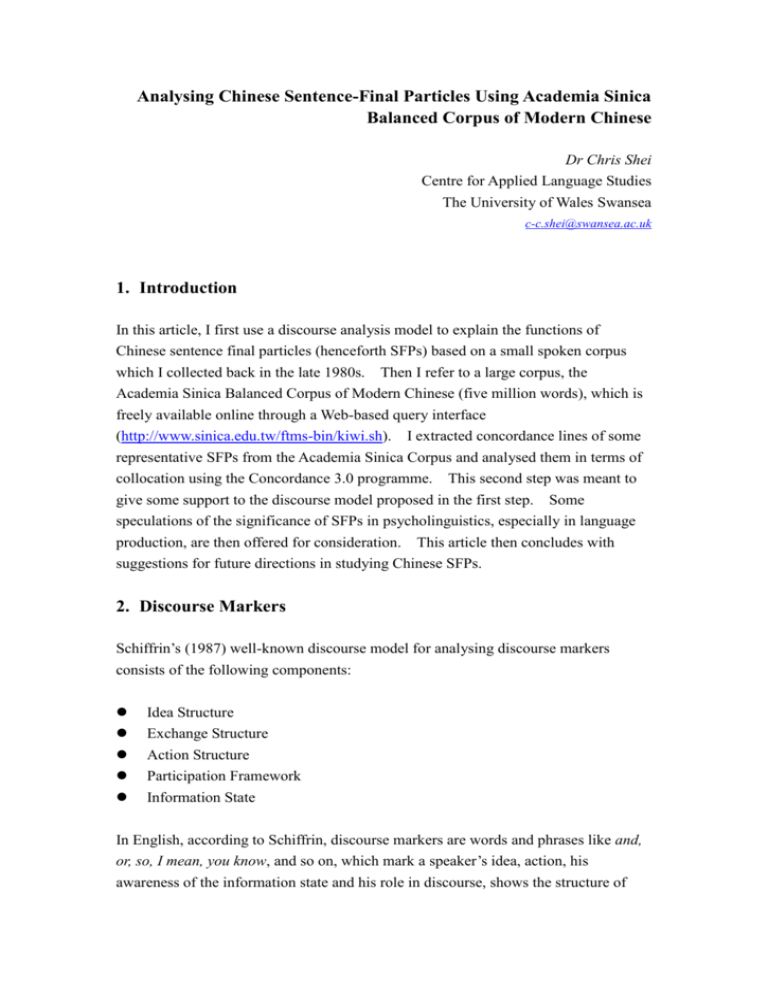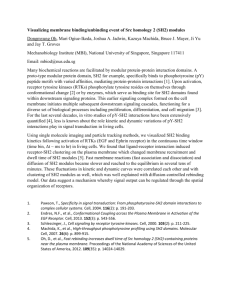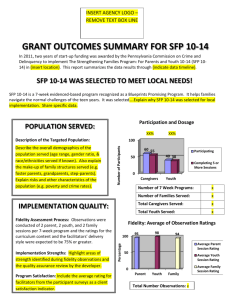Analysing Chinese Sentence-Final Particles Using Academia Sinica
advertisement

Analysing Chinese Sentence-Final Particles Using Academia Sinica Balanced Corpus of Modern Chinese Dr Chris Shei Centre for Applied Language Studies The University of Wales Swansea c-c.shei@swansea.ac.uk 1. Introduction In this article, I first use a discourse analysis model to explain the functions of Chinese sentence final particles (henceforth SFPs) based on a small spoken corpus which I collected back in the late 1980s. Then I refer to a large corpus, the Academia Sinica Balanced Corpus of Modern Chinese (five million words), which is freely available online through a Web-based query interface (http://www.sinica.edu.tw/ftms-bin/kiwi.sh). I extracted concordance lines of some representative SFPs from the Academia Sinica Corpus and analysed them in terms of collocation using the Concordance 3.0 programme. This second step was meant to give some support to the discourse model proposed in the first step. Some speculations of the significance of SFPs in psycholinguistics, especially in language production, are then offered for consideration. This article then concludes with suggestions for future directions in studying Chinese SFPs. 2. Discourse Markers Schiffrin’s (1987) well-known discourse model for analysing discourse markers consists of the following components: Idea Structure Exchange Structure Action Structure Participation Framework Information State In English, according to Schiffrin, discourse markers are words and phrases like and, or, so, I mean, you know, and so on, which mark a speaker’s idea, action, his awareness of the information state and his role in discourse, shows the structure of conversation, and so on. The Chinese SFPs can also be analysed using this framework. In the following sections, seven most frequent SFPs will be discussed on an individual basis, each examined against relevant components in Schiffrin’s model. Hopefully this will give the reader some idea about what Chinese SFPs are and what they do in discourse. 2.1. SFP a The SFP a is a strong indicator of the speaker’s speech act (Action Structure) and a clear indicator of usually the second part of an exchange pair. We will take up the Exchange Structure first. In conversation, a often marks the second pair part of an exchange such as Question-Answer, Assertion-Challenge, Assertion-Endorsement, and so on. A basic example follows: (1) 女: 怎麼 會 一顆 也 不 剩? nv zenmo hui yike ye bu sheng Woman: How come not even one remains? 男: 因為 剩下 的 一定 會 被 你 沒收 啊! nan yinwei shengxia de yiding hui bei ni moshou a Man: Because whatever remains will be confiscated by you! If a is removed from (1), the second pair part is still valid, but some elements are lost, such as the illocutionary force of asserting or accusing, the speaker’s commitment to his own belief, and the overall saliency of the exchange structure. As a general rule, although the SFP does no add anything to the propositional content of an utterance, it contextualises the utterance to a particular point of time in discourse by enforcing speech act, signifying awareness of discourse convention and participation role, and helps manage the flow of information and the state of mutual knowledge. Two interesting effects seem to be evident when a is used to mark an exchange structure: what I will call the distant effect and the recursive effect. (2) 王: 每個 人 的 眼光 不 一樣.也許你 今天 跟 這個 媒婆 wang meige ren de yanuang bu yiyang yexu ni jintian gen zhege meipo Wang: Everyone has own preferences. Perhaps you speak with the match說,我 要 什麼 長相 什麼 長相. 她 也許覺得那個 shuo wo yao shemo zhangxiang shemo zhangxiang ta yexu juede nage maker, saying I want this look, that look. Perhaps she finds someone with a 長相 好看,可是你 不見得 覺得 好看.那 萬一 你不 喜歡 zhangxiang haokan keshi ni bujiande juede haokan na wanyi ni bu xihuan look she likes, but you don’t necessarily like it. Suppose you don’t like it. 這 兩個 人 面對面 多 尷尬! zhe liangge ren mianduimian duo ganga How embarrassing for the two to face each other ! 甲:不 喜歡 可以拒絕, 可以再 相 啊! jia: bu xihuan keyi jujue keyi zai xiang a Jia: You don’t like it, you turn it down and find another blind date. 林: 尷尬 一下 就 過 了啊! lin ganga yixia jiu guo Lin : The embarrassment lasts only a second. 張: zhang Zhang: Indeed, you can turn it down! 王: wang Wang: But people have self-respect! 伊: 我 知道.我 懂 他的 意思. le a 對,可以拒絕啊! dui keyi jujue a 可是,每個人都有尊嚴啊! keshi meigerendouyouzunyana yi wo zhidao wo dong ta de yisi Yi: I know. I understand what he meant. 羅: 沒有 啊!你就 不要 喝他 那個茶 啊! luo meiyou a ni jiu buyao he ta nage cha a Luo: No no no! You could just leave the tea! 不要 放 紅包 給他啊! buyao fang hongbao gei ta a Don’t leave the red envelop for him! A scheme of exchange structure may be helpful here to reveal the function of a in this multi-person conversation. (3) Wang: Assertion 1 (DISLIKE), Assertion 2 (EMBARRASSMENT) Jia: Challenge 1 (REFUSAL), Challenge 2 (DATE AGAIN) + a Lin: Challenge (TRANSIENT) + a Zhang: Endorsement (REFUSAL) + a Wang: Assertion (DIGNITY) + a Yi: Endorsement (DIGNITY) Luo: Response 1 (TEA) + a, Response 2 (RED ENVELOP) + a The distant effect of a as a marker of exchange structure can be seen from Luo’s two assertions fired as responses to Wang’s original assertions that disliking a blind date can cause great embarrassment. Even after five turns’ worth of interruption, Luo’s utterances can still be felt to be responding to Wang’s original assertions. This is largely due to the contribution of a, more specifically, to its conventional use of concluding an exchange pair of an elicitation-response kind. The recursive effect of a as a marker of exchange structure, on the other hand, can be seen from the turn sequence of Wang-Jia-Zhang, where Jia challenged Wang, and Zhang subsequently endorsed Jia’s position. Both Jia’s and Zhang’s utterances are marked by a. Potentially, this could go on indefinitely, with many a’s following one another. Wang-Jia-Wang is another such sequence, where Jia challenged Wang’s original assertion, while Wang’s second assertion in turn challenged Jia’s position. 2.2. SFP ma1 Superficially, or grammatically speaking, the function of ma1 (嗎) in Chinese seems to be to tag a statement and change it into a yes-no question. This might lead us to think that in practice, ma1 might often be used to elicit an exchange. Not so. In conversation, ma1 is often used in the second pair part, accompanying a response rather than an elicitation. An example follows. (4) 婉晴: 也許他 只是 想 引起你 對他的 注意,或者 是 他 想 試探 wanqing yexu ta zhishi xiang yinqi ni dui ta de zhuyi huozhe shi ta xiang shitan Wanqing: Maybe he only wants to get your attention, or he is testing your love 你對 他的愛. ni dui ta de ai for him. 愛華: 父母的愛還 需要 試探 嗎? aihua fumu de ai hai xuyao shitan ma Aihua: Does parents’ love need to be tested? Thus, the fact that ma1 is used in a second pair part seems to imply that it is often used to form a rhetoric question. That is, the question which ma1 helps to form often should be interpreted as a challenge to the previous proposition, rather than a genuine request for confirmation. 2.3. SFP ne The SFP ne is primarily used in discourse to manage the Idea Structure, by contrasting ideas or by asking other participants to complete a proposition, and so on. (5) 馬: 艾大媽,妳 還好 吧? ma Ma: 艾: ai dama ni haihao ba Madame Ai, are you OK? 我 很好, 只是 行動 ai Ai: 馬: wo henhao zhishi xingdong youdian bu fangbian I am fine, just slightly crippled. 那 小芬 呢? ma na xiaofen ne Ma: What about Xiaofen? 有點 不 方便. At the point of Ma’s second turn in (5), the information he has at hand and what he is concerned about is as follows: (6) Subject Predicate Madame Ai Xiaofen fine, slightly crippled (unknown) The function of ne in Ma’s second utterance, then, is to mark Xiaofen as a piece of incomplete information, and to ask the other participant to complete this information, if possible, by analogously referring to her whereabouts and condition, for example. The incomplete piece of information is often an NP, but need not be so. The following is an example of an adverbial clause tagged by ne. (7) 羅: 沒 luo mei ganqing manman peiyang a hai laideji 感情 慢慢 培養 啊!還 來得及啊! a Luo: No affection – affection can be nurtured with time. There is no rush! 伊: 可是,那 萬一 覺得不 適合 呢? yi Yi keshi na wanyi juede bu shihe ne But, suppose they do not fit each other? Here Yi, the second speaker, in the face of the first speaker, Luo’s suggestion that lack of mutual affection in parent-arranged marriage can be amended by time, has a contrasting idea in mind, but only supplies a premise (a conditional) and invites Luo to imagine the consequence. In this kind of situation, ne is necessary and sufficient for the participants to recognise the ‘completeness’ of the incomplete information. (8) is a simple propositional analysis of (7). (8) Condition Action No affection Incompatible by nature Nurture affection (unknown) In this case, the ‘unknown’ part is actually quite obvious in the speaker’s intention – some disastrous consequence. Thus ne can be seen to function in the ideational as well as the action structure – challenging a previous proposition by pointing out an obvious truth. 2.4. SFP ba Like other SFPs, ba has its own preferences as to the kind of ideational and interactive domains it likes to function at. Ideationally, the presence of ba always marks its host utterance with a certain degree of uncertainty. This uncertainty then realises itself in discourse as request for conformation (9), cynicism (10), or invitation for action (11), usually as a sign for closing the interaction. (9) 婉晴: 你 買 這麼 多,花了 不少 錢 吧? wanqing ni mai zhemo duo hua le bushao qian ba Wanqing: You must have spent a lot of money buying so many things? 世莉: 花錢 也是 一種 享受 啊! shili huaqian yeshi yizhong xiangshou a Shili: Spending money is also a kind of joy! (10) 婉晴: 婚前 跟 婚後,差 太多 了 吧? wanqing hunqian gen hunhou cha taiduo le ba Wanqing: Doesn’t there seem too much difference before and after marriage? (11) 君山: 好了,好了,我老婆一笑啊,烏雲全散了. junshan haole haole wo laopo yixiao a wuyun quan san le Junshan: Now, now, my wife has smiled. All clouds are dispersed. 走吧!一塊 吃飯 去,我 請客. zouba yikuai chifan qu wo qingke Come on. Let’s go eat together. My treat. In (11), the SFP ba attaches itself to a verb (zou, ‘walk’), forming an imperative. This functions at two levels in discourse: It not only proposes a physical action of walking away from the scene, but also symbolically attempts to bring an end to the conversation. 2.5. SFP la The SFP la is a discourse marker with a ‘strong character’, being highly evaluative and self-centred. It can signify the speaker’s impatience or contempt towards propositions or entities in discourse. It can also mitigate one’s position or shows the result of one’s retrospection. La can also serve as an ‘information clarifier’. It is one of the most versatile discourse markers in Chinese, functioning in many domains of discourse. (12) 蔡琴: 現在 我們 所 看到 的 外國 影集,其實 是 美國 啦. caiqin xianzai women suo kandao de waiguo yingji qishi shi meiguo la Caiqin: The foreign TV dramas we currently see are actually American dramas. (13) 丹扉:這個 團 呢,不是 旅遊 團 啦,是一個 工作 的 團. danfei zhege tuan ne bushi lvyou tuan la shi yige gongzuo de tuan This group is not a tourist group, but is a working group instead. In both (12) and (13), the SFP la accompanies a piece of information which is used to clarify a vague or inaccurate piece of information. This usage of la in the above examples is for clarifying the speaker’s own information and the tone is only slightly dismissive, targeted at an ‘imaginary enquirer’ at the state of information in discourse. In the following example, the clarification of information by la is further involved in an exchange structure. (14) 迪迪: 媽! didi ma Didi: Mother! 愛華: 怎麼 了?怎麼 了? 唉呀,有沒有 怎麼樣? aihua zenmo le zenmo le aiya youmeiyou zenmoyang Aihua: What’s happening? What’s happening? Gash! Are you OK? 迎迎: 是 他 自己 跌倒 的 啦! yingying shi ta ziji diedao de la Yingying: He tripped and fell himself! 迪迪:是 姊姊 推 我 的 啦! didi Didi: shi jiejie tui wo de la It’s sister who pushed me! Both Yingying and Didi in (14) used la to accompany an authentic piece of information (at least in the speaker’s mind). The presence of la tells the hearer that there is a concurrent proposition which the speaker wants to refute. The two utterances marked by la are actually the two propositions contradicting each other. The fact that the first la-marked utterance has la with it before the contradicting proposition is uttered, means the existence of la need not depend on a superficial exchange structure, as the SFP a does. 2.6. SFP ma5 The pronunciation of ma5 (嘛) is identical to ma1 (嗎) although there are some tonal differences. Unlike ma1, which we saw mainly functions in the action domain by forming a rhetoric question used to challenge, ma5 is concerned primarily with the information state and mutual knowledge. (15) 李: 我竟然發現我看一個電影呢,它因為沒有字幕嘛, li wo jingran faxian wo kan yige dianying ne ta yinwei meiyou zimu ma Li: I was amazed to find that when I watched a film, because it had no subtitles 我 看 電影 可以 看懂 三分之一 的 對白 了 wo kan dianying keyi kandong sanfenzhiyi de duibai le I saw films and found I could understand one third of the dialogues The fundamental function performed by ma5 seems to be to mark some information as particularly obvious and relevant to the current situation. Sometimes it also points to some background knowledge retrievable from the information provided, thereby bringing this knowledge to the foreground as shared knowledge in the discourse domain. In (15), the information marked by ma5 (i.e. that there was no subtitle to the movies) is particularly important as a background for understanding the main thesis of Li’s story (that he achieved one third understanding of the dialogues). 2.7. SFP o There are actually two different SFPs, o2 and o5, which are often represented by the same grapheme 喔. Both are primarily used in the Action Structure, with o2 mainly used for ‘warning’, and o5 mainly used for expressing one’s emotion. example for each below. (16) 男: 小心喔!車 壞了 修理 很貴喔! There is an nan xiaoxin o che huai le xiuli hengui o Man: Be careful! The car costs a fortune to repair if broken down! (17) 男: 我 話 說 的 太快 了.我 好 後悔 喔! nan wo hua shuo de taikuai le wo hao houhui o Man: I was such a big mouth. I am so regretful! In (16), o2 first accompanies an imperative and then a descriptive word, both meant to be a warning against the behaviour of ‘breaking the car’. In (17), o5 is used in a fixed pattern of ‘X hao Y o5’, where X is an entity, time, event, and so on, and Y is a descriptive word. 3. Collocation An interesting thing about collocation of SFP is that, when the collocate of an SFP is omitted from the previous context, leaving the SFP to stand alone in the utterance, the meaning and effect of the omitted collocate are still retrievable from the presence of the SFP. The following is an example from my own corpus: (18) 妻: 奇怪,剛 洗澡 而已,怎麼 老是 在 抓癢? qi qiguai gang xizao eryi zenmo laoshi zai zhuayang Wife: Funny, it just had its bath. Why still scratching away? 夫: 狗 嘛. fu gou ma Husband: As you would expect of a dog. The SFP ma simultaneously fulfils a few roles in discourse: It marks the husband’s utterance as the second part of the Question-Answer pair at the level of Exchange Structure, it brings the partcipants’ background knowledge about dogs into foreground, and it signifies the speaker’s willingness to comply with the previous speaker’s request for an answer to a question. What is more interesting, however, is the fact that there is only a single word, gou (‘dog’) in this utterance apart from ma. A lot of extra information seems to be embedded in ma, which is retrievable by the hearer from the conventional usage of this morpheme. The full proposition could be “because it is a dog, who is in the habit of scratching itself all the time, as we all know”. This is expressed hypothetically in (19), which is possible, though not actually the actual data in the corpus. (19) 妻: 奇怪,剛 洗澡 而已,怎麼 老是 在 抓癢? qi qiguai gang xizao eryi zenmo laoshi zai zhuayang Wife: Funny, it just had its bath. Why still scratching away? 夫: 因為 牠 是 狗 嘛. fu yinwei ta shi gou ma Husband: Obviously because it is a dog. If we replace ma with another SFP, for example, a, the same information cannot be retrieved, as a is not conventionally used in such a position for such purposes. The use of a in (20) is thus relatively unacceptable. (20) 妻: 奇怪,剛 洗澡 而已,怎麼 老是 在 抓癢? qi qiguai gang xizao eryi zenmo laoshi zai zhuayang Wife: Funny, it just had its bath. Why still scratching away? 夫: *狗 啊. fu gou a Husband: Definitely a dog. However, if we replace the ma in (19) with a instead, as shown in (21), the interaction becomes more acceptable, although the Action Structure and Participation Framework somehow change, showing a rather different attitude on the part of the speaker. With a, the utterance becomes more defensive, or aggressive, rather than simply explanatory. (21) 妻: 奇怪,剛 洗澡 而已,怎麼 老是 在 抓癢? qi qiguai gang xizao eryi zenmo laoshi zai zhuayang Wife: Funny, it just had its bath. Why still scratching away? 夫: 因為 牠 是 狗 啊. fu yinwei ta shi gou a Husband: Because it’s a dog, that’s why! This motivates us to find significant collocates for each SFP, so we know what meanings and functions are usually associated with (and therefore can be represented by) individual SFPs. The followings are collocation data initially collected from the bare concordance lines produced from querying Academia Sinica Balanced Corpus of Modern Chinese, and further processed using the Concordance programme (The online Academia Sinica query interface does not seem to produce reliable colloctional analysis). The following is a table showing the statistics of ma5 and its selected collocates. ma5, frequency: 947 Collocate Frequency Joint frequency (4 word to left) z score Examples 因為 2000+ 23 17.46 yinwei ‘because’ 就是 因為戀愛嘛 因為你傷害到別人嘛 因為人家沒抗爭嘛 因為他國小嘛 966 54 62.27 jiushi ‘exactly’ 真的 就是琉球三線蝶嘛 反正就是一個工作嘛 這就是中心一環大家來競選嘛 她們就是姊妹嘛 1194 12 11.67 他們是真的都很有名嘛 這麼大的一個黑點在臉上真的不 好看嘛 真的我們四個人一起修嘛 zhende ‘really’ Table 1: Some significant collocations of ma5 (Note: Unfortunately, the Academia Sinica Balanced Corpus online query interface offers only 2000 lines maximum for each query word. Consequently, the z-score calculated based on this maximum may not be entirely accurate.) From the above selected collocates, which form reasonably strong collocations with ma5, we can see that ma5 is indeed often associated with words denoting the status of information (i.e. information being authentic, having explanatory power, and so on). My suggestion is that when ma5 stands alone in context without obvious support from these collocates, it will still evoke the same meaning on the part of the listener, because of the effect of the collocational convention. As can be expected, we can find a different set of collocates for ma1, which as we said is often used in rhetoric questions in order to challenge a previous proposition. ma1, frequency: 2000+ Collocate Frequency Joint frequency (4 word to left) z score Examples 難道 291 17 24.23 nandao ‘Don’t tell me…’ 知道 2000+ 83 44.62 zhidao ‘know’ 真的 1194 49 34.07 zhende ‘really’ 難道不是這樣嗎? 難道我錯了嗎? 難道不行嗎? 難道不會造成傷害嗎? 難道沒有解決的方法嗎? 我真的很難過妳知道嗎? 你知道我是誰嗎? 你知道我愛上誰了嗎? 你們知道這樣拔有多痛嗎? 馬康多真的發生過屠殺嗎? 真的會不同嗎? 真的有意義和價值嗎? 是真的那麼簡單嗎? Table 2: Some significant collocations of ma1 The collocation of nandao and ma1 (‘Don’t tell me it is the case that…’) is a rather strong form of rhetoric question indeed, usually used in arguments, debates, protests, and so on. The collocation of ma1 with zhidao (‘Are you aware of… at all?’), in the same vein, implies the addressee’s likely stupidity or ignorance. Finally, when ma1 collocates with zhende (‘really’), it casts doubts on a certain existing proposition. We will take another example to see how the discourse function based analysis goes with the collocation based analysis. The following table is for ba: ba, frequency: 1949 Collocate Frequency Joint frequency (4 word to left) z score Examples 大概 691 20 18.23 dagai ‘roughly’ 還是 他的牙齒大概只剩兩三顆吧! 大概二三十年吧 大概是昨天半夜裡頭吧? 大概也聽煩了吧! 2000+ 23 11.26 haishi ‘still’ 算了 還是讓他回家休息吧 你還是回去吧 我們還是停了吧 我還是回台灣吧 96 16 40.97 算了吧 suanle ‘forget it’ Table 3: Some significant collocations of ba Again, we find that some collocates can be taken out of the collocation while still allowing the SFP to retain their meanings. In the above table, dagai (‘approximately’) often collocate with ba to present some uncertain information, either regarding quantity or quality. This seems to be a prototypical collocation for ba, as even when not accompanied by words like dagai or huoxu (‘maybe’), ba still gives out this meaning, as in the following. (22) 其 所需 時間 將 數倍 於此 吧 qi suoxu shijian jiang shubei yuci ba The required time will be many times this amount. The English translation in (22) sounds like affirmed information, while in effect, with the added meaning of ba, there should be some degree of uncertainty in it, like “I think…”. With this element of uncertainly in ba’s meaning, the imperatives formed by ba is less demanding, and it can also be used as a mild suggestion to close the conversation or a certain topic in the conversation. Finally, a ‘side effect’ of collocational analysis of SFPs regarding their orthography is worth noting. The orthographic conventions for some homophonic SFTs are often confusing. For example, we have seen that o2 and o5 perform very different functions. They should be represented by different graphemes, but in practice, two Chinese characters are regularly used interchangeably for these two morphemes: 喔 and 哦. This can be seen from their similar, rather then complementary, collocational patterns. 喔 o, frequency: 950 Collocate Frequency Joint frequency (4 word to left) z score Examples 好 2000+ 161 129.38 hao ‘good’ 不要 好漂亮喔 好可怕喔 好丟臉喔 好辛苦喔 2000+ 7 4.45 可不要叫苦連天喔 不要把籽吞下去喔 千萬不要學他們錯誤的行為喔 不要輸不起喔 buyao ‘don’t’ Table 4: Some significant collocations of 喔 o 哦 o, frequency: 662 Collocate Frequency Joint frequency (4 word to left) z score Examples 好 2000+ 64 61.17 hao ‘good’ 不要 好漂亮哦 好可怕哦 好好聽哦 好棒哦 2000+ 8 6.75 你不要走哦 你不要緊張哦 千萬不要錯過了哦 你不要認為布馬戲只是供人消遣 的而已哦 buyao ‘don’t’ Table 5: Some significant collocations of 哦 o It can be seen from the two prominent collocations selected in the above two tables, both 喔 and 哦 have similar (in some cases identical) collocates. This shows that the two morphemes are used interchangeably by Chinese writers to express two functionally and phonetically different SFPs, o2 and o5, although the character 喔 seems to be more often used to represent o5 (the expressive meaning), while 哦 seems slightly more strongly associated with o2 (the ‘warning’ meaning). Collocational analysis helps us to become aware of the issue of ambiguous orthography. 4. Psycholinguistic aspect Levelt (1989) proposed that we view speech production as starting from the generation of a dynamic series of communicative intentions, each of which is instantly decomposable into a set of sub-goals. Each sub-goal is further assigned a speech act to accomplish it. Each speech act will involve the transmission of an information unit and, for each of these, the information structure and the prepositional format must be decided on which can best achieve the communicative goals. Henceforth, the output (called “preverbal message” by Levelt) is fed into the Formulator, which has a grammatical encoding department and a phonological encoding department and has access to a mental lexicon. The lemmas in the lexicon conduct the important task of mapping conceptual information to grammatical function. The end product of this stage is a surface string with pronounceable phonetic plan. If we look at the production of SFP-tagged sentences from this perspective, it seems questionable whether an SFP has a lemma or not in Levelt’s scheme, or is it a ‘direct descendant’ from the pragmatic level or, more specifically, from the level of speech act. For Levelt a lemma contains semantic and syntactic information, but no phonetic form. This is used to explain the tip-of-the-tongue phenomenon, where we have the lemma (knowing the meaning and grammatical property of the word form) but not the form itself. The SFP, on the other hand, has very little semantic content by itself, and the grammatical property is so simple and straightforward (‘go to the end of an utterance’) there is really no need for ‘functional processing’ or ‘positional processing’ (for these two terms, see Bock and Levelt’s 1994 model of sentence processing) to occur. In other words, an SFP may be decided on very early in the production of a sentence and then exerts a top-down control on all other elements in the sentence, including the form and length of the sentence. Two observable phenomena can be used to support the claim that SFPs are one of the first elements to be encoded in forming a sentence: one is the length of the sentence tagged by an SFP; the other is the integration of the SFP to the previous elements in the same sentence. In reviewing the significance of pause in speech production, Harley (1995, p.245) notes that pause before less predictable word signifies difficulty in lexical access. Conversely, we can say that before a highly accessible item like the Mandarin SFP, which we proposed to have been predetermined at the conceptual level, pause should be more unlikely than likely. Indeed, in a Chinese speaker’s retrospection, pause is a highly unlikely feature before a Chinese SFP. In fact, not only that pause is not possible before an SFP, going one step farther, the SFP actually tends to merge with the preceding Chinese character of a certain kind. Thus le a becomes la, and le o becomes lo in Mandarin Chinese. The no-pause phenomenon helps support the hypothesis that the use of a certain SFP is determined very early in speech production: probably as soon as a specific speech act is decided upon. This assumption is further supported by the general impression that the sentence being marked by an SFP is often very short, presumably because, under the present theory, the limited capacity of working memory is already committed to the remembering of the most distant element of a sentence – the sentence final particle and associated information. Whatever needs to be filled in the slots before the SFP therefore has to be manageable by the limited cognitive capacity. In fact, one researcher in Chinese linguistics (Halvor 1995) actually proposes that SFPs be used as a marker of boundary of a Chinese clause, which is typically very short. Unfortunately, the sentence boundaries in Chinese are notoriously difficult to decide and the issue of sentence length remains subjective; while the existence or non-existence of pause cannot be seen at all from the current way of representing spoken discourse in corpora, at least in the case of Academia Sinica Balanced Corpus of Modern Chinese. 5. Conclusion The Chinese sentence-final particles can now be studied via the corpus-based approach. In particular, the collocation of SFPs with other lexical items helps us to identify the specific characters of individual SFPs in terms of their ideational contents and discourse functions. However, if we want to go deeper than the concordance lines offered by most current corpora, we need to design more discourse and psycholinguistics oriented corpus annotation and interfaces. References Bock, K and Levelt, W. (1994) Language Production: Grammatical Encoding. In M. Gernsbacher (ed.) Handbook of Psycholinguistics (New York: Academic Press), 945-984. Halvor, E. (1995) Clause Combination in Chinese (Leiden: E.J. Brill). Harley, T.A. (1995) The Psychology of Language: From Data to Theory (Hove: Erlbaum). Levelt, W.J.M. (1989) Speaking: From Intention to Articulation (The MIT Press: Cambridge, Mass.). Schiffrin, D. (1987) Discourse Markers (Cambridge: Cambridge University Press).








